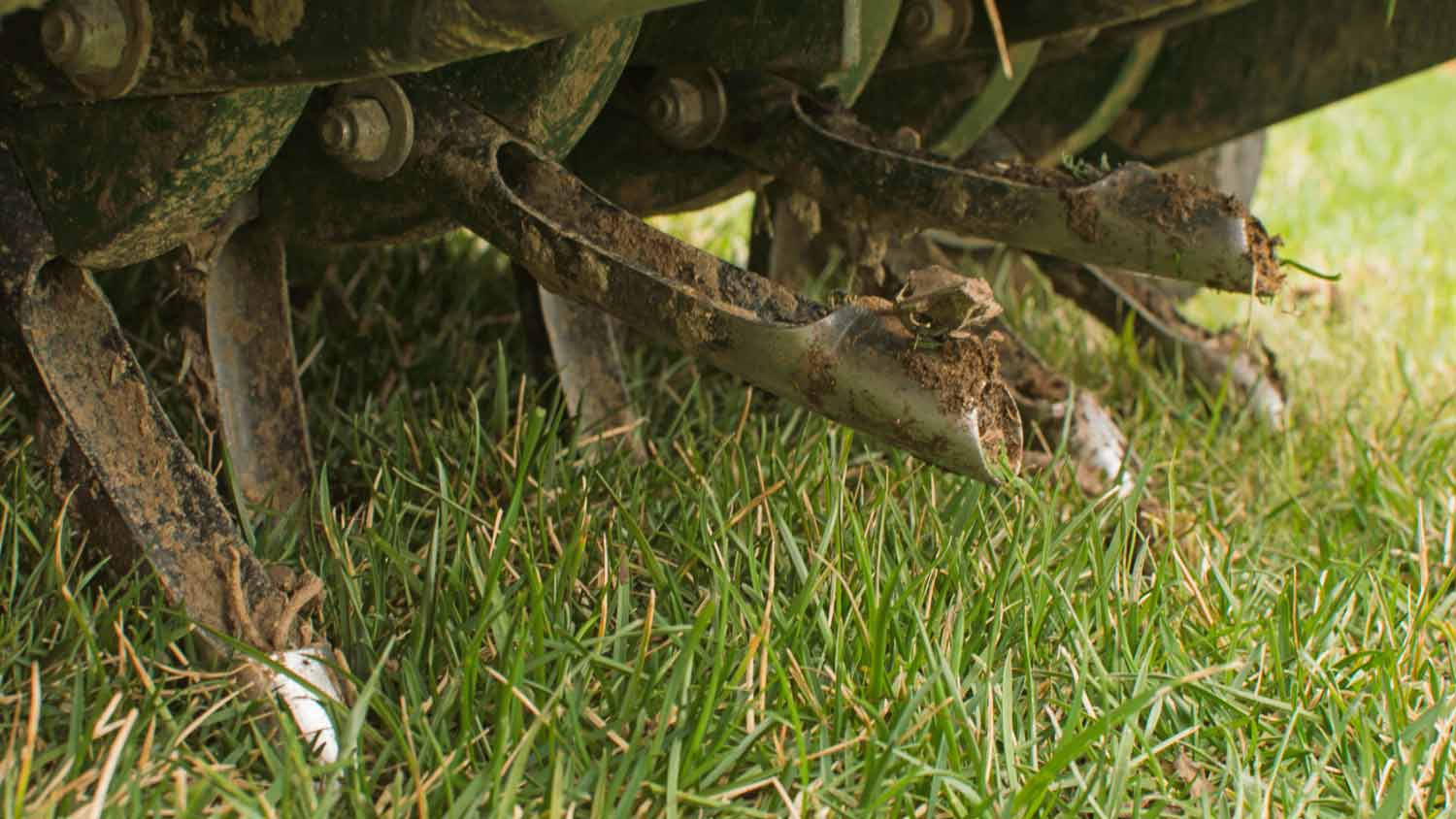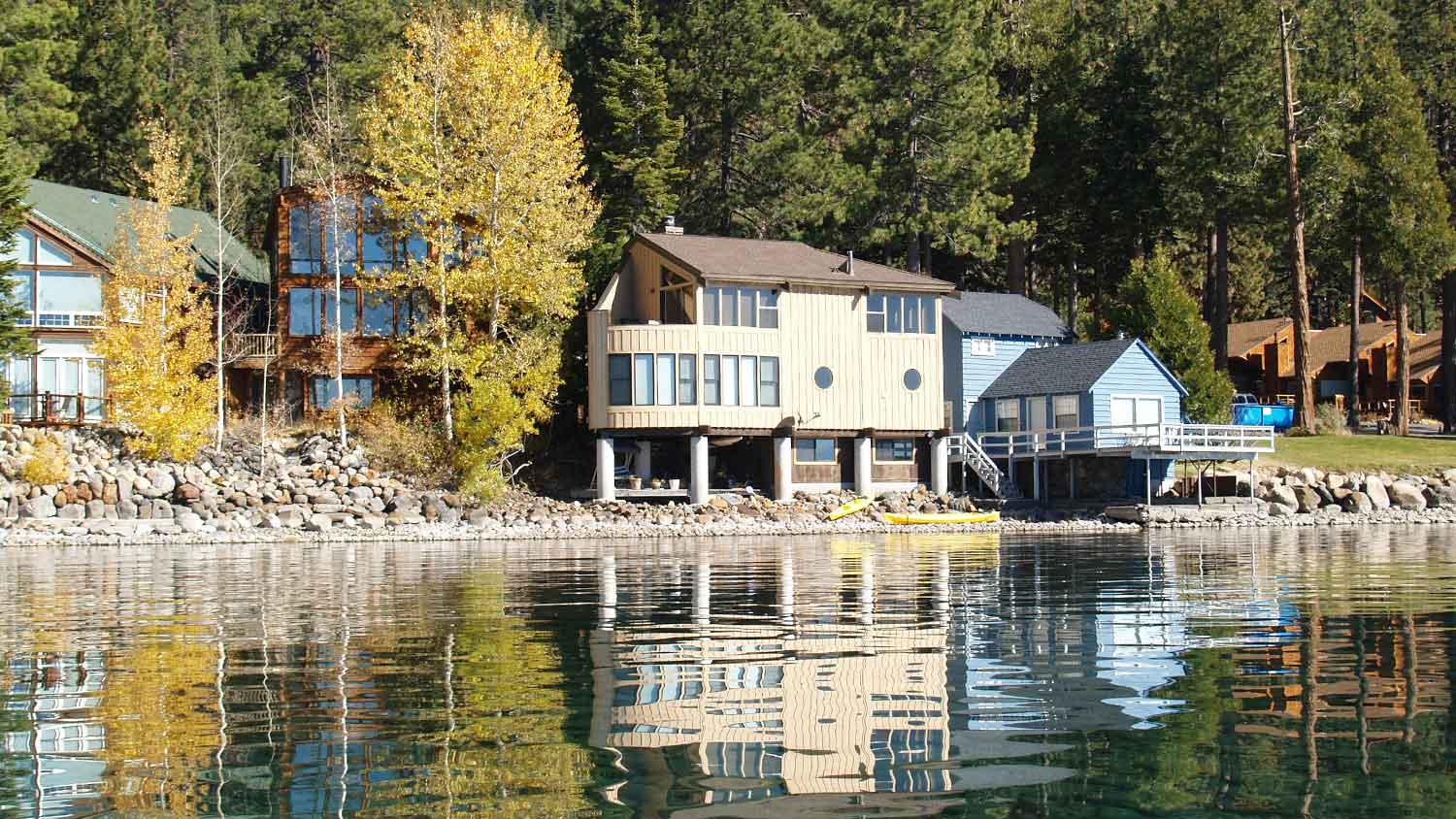
We break down the cost to remove bamboo, which is slightly higher than other forms of tree removal. It's a difficult DIY task because of bamboo's hardy underground roots.
Both tools make your lawn look lush, so which should you choose?


Professional power raking costs $215 on average.
Hiring someone to aerate your lawn is $140 on average.
If you choose DIY aeration, you have many tools and processes to pick from.
When you power rake, you’ll want to re-seed your lawn immediately after.
You can hire someone to aerate and power-rake your lawn all at once.
If your lawn is dull, browning, or less than lush, chances are you’re considering power raking or aeration to get things healthy again. Both will undoubtedly improve your lawn in the long term, but each service has different use cases, benefits, and costs. Let’s mow down the differences between aeration vs. power raking.
Both aeration and power raking help your lawn by strengthening root systems, improving drainage, and getting more sun and nutrients to the soil. However, power raking and aeration have major differences in terms of function. Power raking physically removes a dead layer of grass on your lawn. Aeration punctures holes in your lawn physically, mechanically, or chemically.

Power raking is a form of dethatching. Dethatching a lawn removes the layer of dead grass between the new growth and the soil, making it easier for healthy grass to grow and take root. While you can dethatch using a rake or chemicals, power raking is an aggressive form of dethatching that relies on machinery.
| Pros | Cons |
|---|---|
| Improves the look of a lawn | Tough on lawn |
| Removes lawn thatch | Doesn’t solve compacted soil |
| Prep for overseeding | Need to overseed |
| Better nutrients | More expensive |
Best for:
Lawns with at least half an inch of accumulated thatch.
Gardeners who plan to overseed their lawn.
People who plan to bundle professional lawn services.
Power raking immediately improves the look of the lawn. Your green, healthy grass will immediately pop with a thick layer of thatch removed. You’ll be surprised by how much the brown, drab thatch was clogging up the look of your yard.
It quickly removes thick thatch from a lawn. While you can dethatch a lawn using a rake, removing a thick layer of thatch will take several passes. Power raking will quickly and efficiently remove thick thatch layers from your lawn.
It prepares the lawn for overseeding. While power raking can be tough on your lawn, tearing through some of the grass and soil, it’s one of the best and easiest ways to prep a lawn for overseeding.
Power raking can be tough on your lawn. Power raking uses mechanical shears, crisscrossing the soil to remove the thatch layer. Since it’s an intense process, you shouldn’t do it unless more than half an inch of thatch has accumulated. You’ll also want to overseed soon after to encourage new growth and repair.
It’s less effective at tackling compacted soil. Power raking removes thatch but doesn’t address any issues below the soil. If a lawn is compacted, power raking won’t effectively aerate it.
You need to overseed after. You can’t just power rake and call it a day, as it can damage your lawn in the long term. You’ll have to overseed your lawn or hire someone to do it.
Power raking is more expensive than other dethatching methods. Renting a power rake will cost more than other detaching tools, like a manual rake or chemical dethatcher.

At its core, aerating is basically poking holes in the soil using a physical, mechanical, or chemical tool. This can help loosen compacted soil, restore nutrients, improve drainage, and strengthen root systems. As you move an aerating tool across a lawn, it’ll pull up plugs of dirt, loosening the surrounding soil.
| Pros | Cons |
|---|---|
| Affordable DIY | Physically demanding |
| Gentle | Tough on lawn |
| Improves drainage, root system | No foot traffic |
| Different methods | Not all effective |
Best for:
Compacted lawns.
Casual DIY-ers.
Lawns with heavy traffic.
Aeration is affordable to DIY. Physical aerating tools and liquid aerators are affordable, typically less than $20 a gallon. Renting a mechanical core aerator isn’t much more.
It’s gentle on your lawn. While aerating involves removing cores of compacted soil, it’s relevantly gentle on the lawn compared to other maintenance projects.
Aeration improves drainage and root systems. When soil is less compacted, it drains more easily and encourages root growth.
There are many different aerating methods. You can aerate using shoes, spike aerators, liquid aerators, or even pitchforks.
Can be physically demanding. Manually aerating a lawn with a pitchfork or spike aerator can save you money but can be exhausting.
Slightly injurious to lawns. While it benefits the lawn in the long term, aerating can be tough on lawns at the outset.
Need to avoid walking on the lawn after. To avoid further damaging the lawn, you should avoid walking on it for a few weeks after aerating. This can be tough for high-traffic lawns.
Not all methods are equally effective. Large, mechanical core aerators will be more effective than pitchforks or spike shoes.
Choosing power raking versus aeration will first come down to the issues plaguing your lawn. Is it a thick layer of thatch or hard compacted soil underfoot? If it’s a combination of the two, you’ll want to weigh the pros and cons of each.
You may not save time, but if you don’t mind the physical labor that comes with manual aeration, you’ll save a lot of money. Aerating your lawn costs $140 on average, but if you have a pitchfork or other aeration tool on hand, you won’t need to spend a dime.
You’ll pay anywhere between $75 and $200 to hire a professional lawn aerator in your area. But, calling in the pros to power rake your lawn can cost between $100 and $700, depending on the size of the yard.
What’s more, with power raking, you’ll need to overseed the lawn right after, which you can do yourself or roll into the professional service. Tacking on overseeding to an professional aeration or power raking job can cost anywhere between $100 to $160, depending on the size of the yard.
Both power raking and aeration will improve the look of your lawn, but in aerating, the benefit is somewhat secondary. Power raking will immediately cut through thick thatch accumulated on a lawn, and after overseeding, you’ll see new growth quickly.
Power raking is more likely to improve the appearance of your lawn.
Power raking requires heavy-duty machinery, which must be connected to a riding mower or trailer. Mechanical aerators are similar, but the process becomes much more DIY-friendly if you want to use a liquid aerator or manual aeration tool.
However, if you want to use machinery, you likely won’t save money to rent equipment and DIY. Plus, aerating and power raking benefit from overseeding or fertilizing the lawn afterward, which can be affordably rolled into a professional service.
From spike shoes to liquid aerators and pitchforks, aeration has many more options to customize your treatment than power raking does. Power raking is a more specific process within dethatching, which requires heavy machinery and fewer options.
From average costs to expert advice, get all the answers you need to get your job done.

We break down the cost to remove bamboo, which is slightly higher than other forms of tree removal. It's a difficult DIY task because of bamboo's hardy underground roots.

Leveling your yard can help with drainage and prevent damage to your home. Learn the cost to level a yard in Columbus, OH, and what factors can affect the price.

From your flower beds to your walkway, river rocks make a classic addition to your landscape. Learn about the cost to install river rock to set a proper budget.

Riprap prevents erosion and protects your shoreline when done right. Learn who to hire for riprap and how to find a licensed professional.

Are you wondering, “Who can I hire to aerate my lawn?” Learn how to find and hire a local lawn service to get the job done and make your yard look healthy.

Try these 10 backyard improvements to turn your backyard into your own personal oasis.